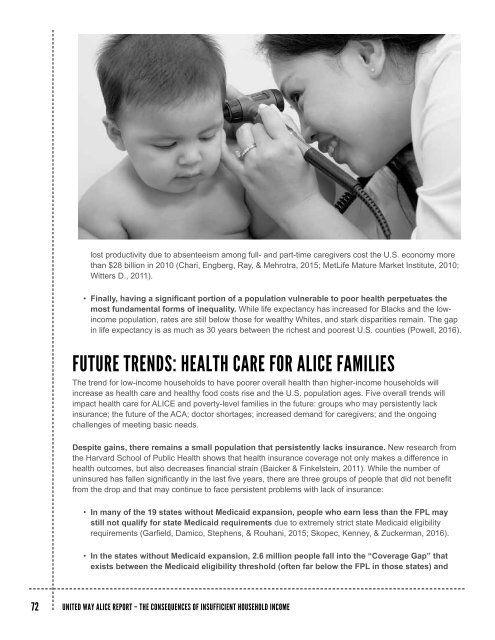The Consequences of Insufficient Household Income
This new Consequences of Insufficient Household Income report provides a deeper level of understanding of the choices that ALICE and poverty-level families across the country make when they do not have enough income or assistance to afford basic necessities, and the consequences of those choices.
This new Consequences of Insufficient Household Income report provides a deeper level of understanding of the choices that ALICE and poverty-level families across the country make when they do not have enough income or assistance to afford basic necessities, and the consequences of those choices.
Create successful ePaper yourself
Turn your PDF publications into a flip-book with our unique Google optimized e-Paper software.
lost productivity due to absenteeism among full- and part-time caregivers cost the U.S. economy more<br />
than $28 billion in 2010 (Chari, Engberg, Ray, & Mehrotra, 2015; MetLife Mature Market Institute, 2010;<br />
Witters D., 2011).<br />
• Finally, having a significant portion <strong>of</strong> a population vulnerable to poor health perpetuates the<br />
most fundamental forms <strong>of</strong> inequality. While life expectancy has increased for Blacks and the lowincome<br />
population, rates are still below those for wealthy Whites, and stark disparities remain. <strong>The</strong> gap<br />
in life expectancy is as much as 30 years between the richest and poorest U.S. counties (Powell, 2016).<br />
FUTURE TRENDS: HEALTH CARE FOR ALICE FAMILIES<br />
<strong>The</strong> trend for low-income households to have poorer overall health than higher-income households will<br />
increase as health care and healthy food costs rise and the U.S. population ages. Five overall trends will<br />
impact health care for ALICE and poverty-level families in the future: groups who may persistently lack<br />
insurance; the future <strong>of</strong> the ACA; doctor shortages; increased demand for caregivers; and the ongoing<br />
challenges <strong>of</strong> meeting basic needs.<br />
Despite gains, there remains a small population that persistently lacks insurance. New research from<br />
the Harvard School <strong>of</strong> Public Health shows that health insurance coverage not only makes a difference in<br />
health outcomes, but also decreases financial strain (Baicker & Finkelstein, 2011). While the number <strong>of</strong><br />
uninsured has fallen significantly in the last five years, there are three groups <strong>of</strong> people that did not benefit<br />
from the drop and that may continue to face persistent problems with lack <strong>of</strong> insurance:<br />
• In many <strong>of</strong> the 19 states without Medicaid expansion, people who earn less than the FPL may<br />
still not qualify for state Medicaid requirements due to extremely strict state Medicaid eligibility<br />
requirements (Garfield, Damico, Stephens, & Rouhani, 2015; Skopec, Kenney, & Zuckerman, 2016).<br />
• In the states without Medicaid expansion, 2.6 million people fall into the “Coverage Gap” that<br />
exists between the Medicaid eligibility threshold (<strong>of</strong>ten far below the FPL in those states) and<br />
72 UNITED WAY ALICE REPORT – THE CONSEQUENCES OF INSUFFICIENT HOUSEHOLD INCOME




